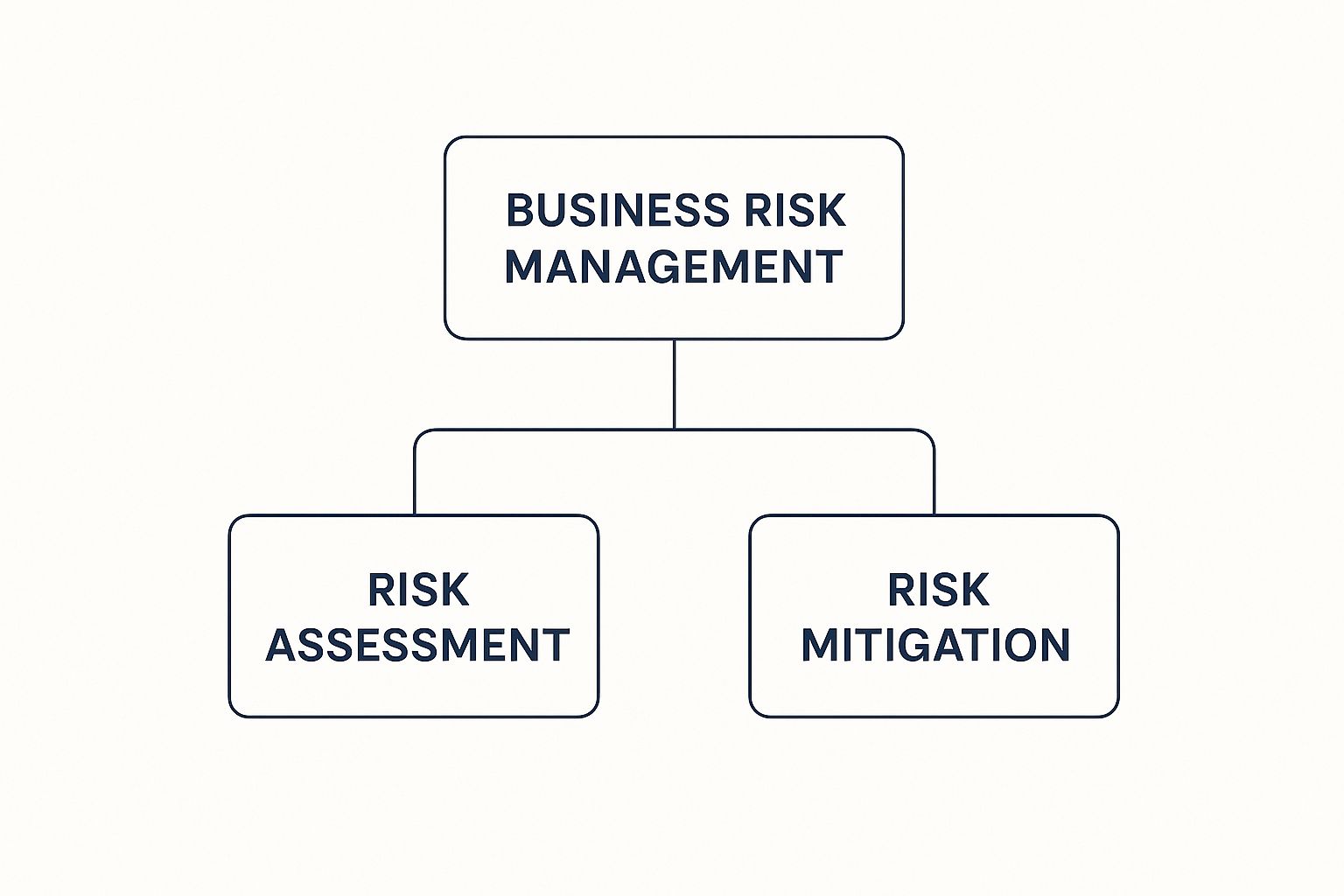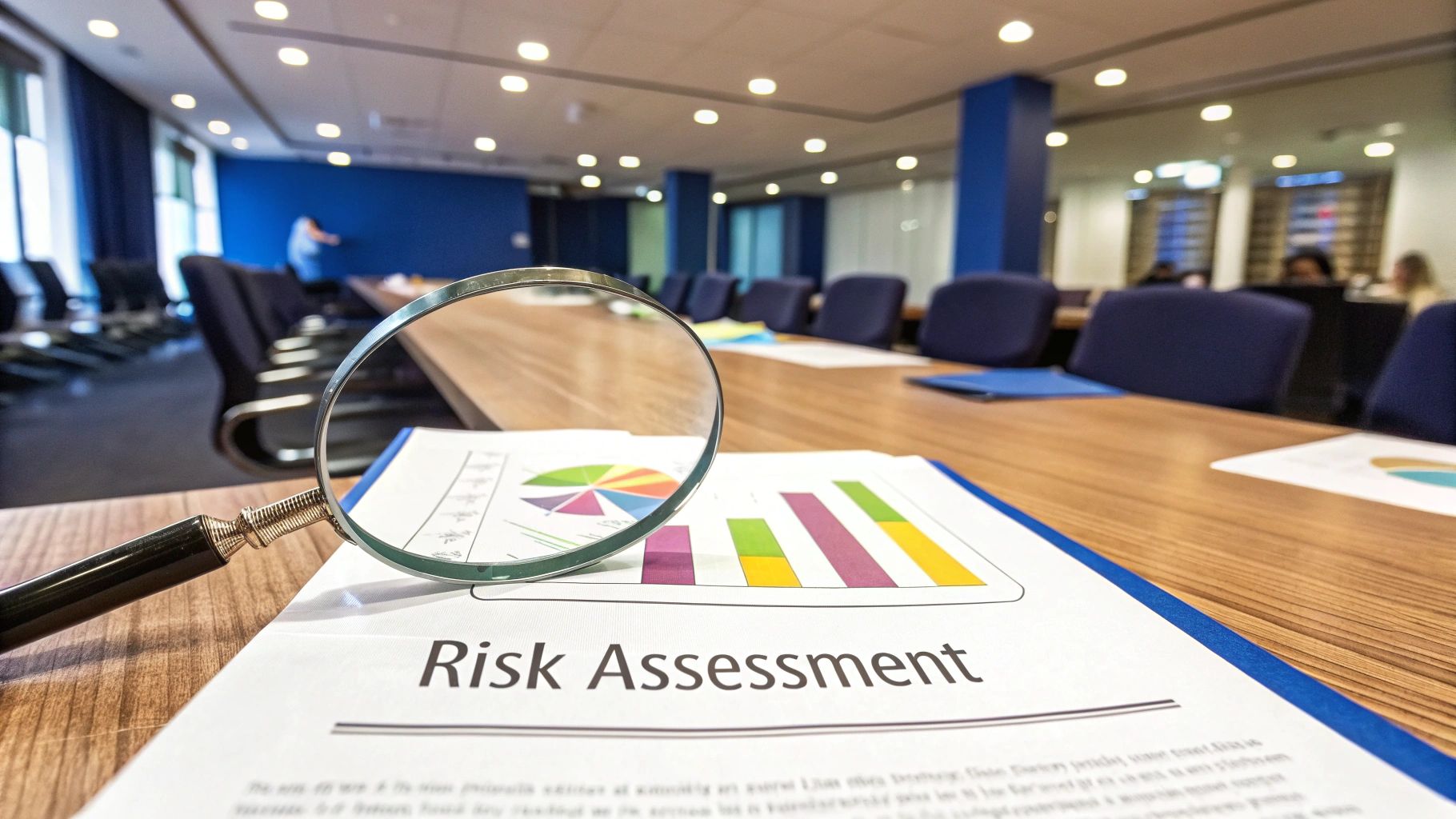A Guide to Risk Management for Businesses
- Showix technical Team
- Jul 16
- 15 min read
Updated: Jul 26
Effective risk management for businesses is so much more than just firefighting; it’s a genuine strategic advantage. It's the playbook that helps a company not only guard against threats but also confidently chase opportunities in the often-unpredictable world of business.
Why Risk Management Is Your Business Superpower
Picture your business as a ship and you as its captain. A beginner captain might only focus on steering clear of storms. But a seasoned captain? They understand the weather, know the ship's capabilities inside and out, and can even use a challenging wind to get to their destination quicker and safer.
That’s what good risk management is all about. It isn’t about trying to eliminate every single risk—that’s just not possible. It's about understanding them so deeply that you can make smarter, more informed decisions.
This proactive mindset shifts your entire company from a defensive crouch to a confident, forward-moving stance. When you get ahead of potential problems, you protect what matters most, keep things running smoothly, and build an organisation that can take a punch and keep going.
The Four Core Pillars of Business Risk Management
At its heart, managing risk is about bringing a sense of order to uncertainty. It lets you look ahead, anticipate what's coming, and prepare your response. The process generally boils down to four key stages, each building on the last.
The table below breaks down these fundamental pillars of the risk management cycle.
Pillar | Objective | Key Activities |
|---|---|---|
1. Identify | To find and list all potential risks that could affect the business. | Brainstorming sessions, reviewing past incidents, market analysis, compliance checks, talking to staff. |
2. Assess | To understand the likelihood and potential impact of each identified risk. | Using a risk matrix (likelihood vs. impact), financial modelling, vulnerability assessments. |
3. Mitigate | To develop and implement strategies to reduce, transfer, or accept the risk. | Creating new procedures, buying insurance, setting up backup systems, staff training, outsourcing. |
4. Monitor | To continuously track risks and review the effectiveness of control measures. | Regular audits, performance reporting, staying updated on industry trends, updating the risk register. |
This cycle isn't a one-and-done task; it’s a continuous loop that helps your business stay agile and prepared for whatever comes next.

As you can see, the process moves logically from understanding the risk landscape to taking decisive action to control it.
What's Really at Stake?
Choosing to ignore these principles can have dire consequences. In the UK, a shocking 44% of Small to Medium-sized Enterprises (SMEs) don't have any commercial insurance at all. On top of that, about 40% are underinsured, leaving them incredibly vulnerable to financial ruin if something unexpected happens.
These figures show just how many businesses are walking a tightrope without a safety net—a problem that a solid risk management plan can solve directly.
A strong risk management programme transforms uncertainty from a threat into a manageable variable. It provides the confidence needed for bold decision-making, which is the engine of sustainable growth.
Ultimately, it all comes down to control. You can’t control every external event, but you absolutely can control how prepared you are and how you respond.
Sometimes, this means looking inward to uncover threats that could be damaging your business from the inside. Understanding why corporate investigations are crucial for business integrity is a vital piece of the puzzle. It’s this complete, 360-degree view that elevates risk management from a simple chore to a powerful competitive edge.
Identifying the Risks That Truly Matter

Good risk management for businesses all starts with a simple, honest question: what could really go wrong here? To answer that properly, you have to look past vague anxieties and zero in on the specific threats that are relevant to your company, your market, and even your postcode.
Not all risks are created equal. The secret to an effective strategy is focusing your time and energy on the threats that could actually cause some damage, rather than trying to solve every hypothetical problem under the sun.
To make sense of it all, it helps to group potential threats into a few logical categories. Think of it like tidying up a messy workshop—you wouldn't just throw all your tools into one big box. By creating specific drawers for different tools, you can instantly see what you have, what’s missing, and what needs sharpening.
Common Categories of Business Risk
A great way to start organising your thoughts is to use a few primary buckets. While every business has its unique quirks, most threats will neatly fall into one of these areas:
Financial Risks: This is anything that directly threatens your cash flow and financial stability. It could be a sudden spike in the cost of raw materials, an unexpected interest rate rise from the bank, or a major client going bust before they pay a hefty invoice.
Operational Risks: These are the spanners in the works of your daily routine. Think of essential machinery grinding to a halt, a key supplier suddenly disappearing, or a logistical nightmare that prevents you from getting your products to customers.
Compliance Risks: This bucket covers the risk of falling foul of the law, regulations, or industry standards. In the UK, that could mean anything from a GDPR breach to failing to meet health and safety rules. The consequences aren't just fines; they can seriously damage your reputation.
There is, however, one threat that has become so significant for modern businesses that it really deserves a category all of its own.
The Number One Threat: Cyber Risk
Today, one risk looms larger than almost any other in its power to cause chaos and financial ruin: cyber risk. This isn't just a problem for big banks or tech giants anymore. If your business uses email, holds customer data, or has a website, you are a target.
According to the Allianz Risk Barometer, cyber incidents have consistently been ranked as the number one risk for UK businesses. This isn't just about hackers; it covers everything from ransomware attacks that hold your data hostage to breaches that leak sensitive customer information. You can read more about why cyber threats top the list for UK companies in their full report.
As we rely more and more on digital systems, a single cyber attack can stop a business in its tracks, shatter customer trust, and lead to eye-watering financial penalties. It has to be a top priority for any serious risk management plan.
Getting your head around this specific threat is absolutely vital for survival in today's world.
How to Uncover Your Specific Risks
So, how do you find out what your specific risks are? It’s not a passive exercise. You can't just download a generic checklist and assume you're covered. You need to roll up your sleeves and create a risk register—a living document that lists out the threats unique to your business.
Here are a couple of practical ways to get started:
Team Brainstorming: Pull key people from different departments into a room. Ask them a straightforward question: "What keeps you up at night about your job?" Your sales manager might be worried about a new competitor, while your warehouse manager is losing sleep over an old, unreliable forklift. These on-the-ground insights are pure gold.
SWOT Analysis: Take a hard look at your business through the classic lens of Strengths, Weaknesses, Opportunities, and Threats. Your Weaknesses (like outdated software) and Threats (like shifting customer habits) are a direct pipeline into your risk register.
By sorting threats into categories and actively looking for them, you go from vague worrying to structured, practical awareness. This groundwork is the essential foundation for everything that follows. Without it, you’re just flying blind.
Building Your Practical Risk Management Framework

Once you’ve got a handle on the threats facing your company, it’s time to build a formal plan. This doesn't have to be some hundred-page beast that just gathers dust on a shelf. An effective risk management for businesses framework is really just a playbook that helps your team react in a coordinated, resilient way when things go sideways.
Think of it as setting the rules of the game before you start playing. A good framework ensures everyone knows their role and what the goal is. It turns potential chaos into a structured response, giving your business a solid foundation for navigating uncertainty.
Setting Clear Objectives for Your Plan
First things first, your framework needs a clear purpose. Are you trying to protect specific company assets? Is the main goal to keep the lights on during a crisis? Or are you focused on ticking the boxes for strict regulatory standards? Defining these objectives upfront gives you focus and a way to measure success later on.
Just ask yourself: "What does this plan need to do for us to call it a success?" The answer to that simple question will steer every other decision you make. This clarity is the bedrock of any practical, powerful risk management strategy.
A great place to start is by planning for a ‘reasonable worst-case scenario’. This isn't about being pessimistic; it's a pragmatic approach used by large organisations, including the UK government for its National Risk Register. It helps you create proportionate plans without getting bogged down by every single possibility under the sun.
Defining Your Company's Risk Appetite
One of the most crucial parts of your framework is defining your risk appetite. In simple terms, this is how much risk your business is willing to take on to achieve its goals. It's a strategic decision that should reflect your company's culture and what you're trying to accomplish.
Your risk appetite acts as a guidepost for your entire team. It helps ensure that decisions made at every level of the organisation are consistent with the company's overall tolerance for risk.
Are you an ambitious tech startup happy to embrace market risks for a shot at rapid growth? Or are you a stable, family-run business that puts consistency above all else? There’s no right or wrong answer here, but being honest about where you stand is essential. It stops you from making reckless gambles while also making sure you don't miss out on good opportunities by being too cautious.
Assigning Roles and Responsibilities
A plan is pretty useless if no one knows who’s supposed to do what. Your framework must clearly outline who is responsible for each part of the process. This isn’t about playing the blame game when things go wrong; it’s about empowering people to act decisively when a threat appears.
Clear roles mean a smoother, more efficient response. Key responsibilities to assign include:
Risk Owner: The individual or team in charge of managing a specific risk. For example, your IT manager would naturally "own" cybersecurity risks.
Action Implementer: The person tasked with carrying out specific actions, like running staff training sessions or updating software.
Oversight Lead: A senior leader—often the business owner or a director—who has the final say and is ultimately accountable for the entire framework.
This structure creates clear accountability and cuts through the confusion during a crisis. It's especially important for internal threats like corporate fraud, where a swift, organised response is critical. You can learn more by checking out our guide on https://www.sentryprivateinvestigators.co.uk/post/a-guide-to-corporate-fraud-investigation to see how structured roles help manage these complex situations.
As you map all of this out, using tools like business continuity planning software can really help streamline the process of organising your plans and assigning these vital roles.
Actionable Strategies for Mitigating Business Risks

Once you’ve identified and sized up the potential threats to your business, it’s time to move from planning to action. This is the crucial stage where you actively get a grip on the risks you've uncovered and minimise their potential impact.
Think of it this way: effective risk management for businesses isn't just about making a list of what could go wrong. It’s about having a clear, ready-to-go response for every single item on that list.
There are four main ways to handle any given risk. You can think of them as a toolkit. You wouldn't use a sledgehammer to fix a watch, and you wouldn't use tweezers to knock down a wall. The trick is always to pick the right tool for the job.
The Four Core Mitigation Strategies
Your response to a risk will almost always fall into one of four buckets: Avoid, Reduce, Transfer, or Accept. A truly solid risk management plan will use a blend of all four, applying them where they make the most commercial sense.
Let's break down what these strategies mean in the real world. This table gives a quick overview, with practical examples tailored for a typical UK small or medium-sized enterprise (SME).
Risk Mitigation Strategies at a Glance
Strategy | What It Means | Example for a UK SME |
|---|---|---|
Avoidance | Deciding not to engage in an activity that carries an unacceptable level of risk. | A catering company decides not to offer services for large outdoor festivals during winter due to the high risk of weather-related cancellations and financial loss. |
Reduction | Implementing measures and controls to lower the likelihood or impact of a risk. | A retail shop installs high-quality CCTV and trains staff on security protocols to reduce the risk of theft. |
Transference | Shifting the financial burden of a risk to another party, most commonly an insurer. | A construction firm takes out comprehensive public liability insurance to transfer the financial risk of accidents on a building site. |
Acceptance | Consciously choosing to live with a risk, typically when its impact is minor and the cost of mitigation is too high. | A small office accepts the minor risk of occasional printer malfunctions, budgeting a small amount for repairs rather than buying an expensive service contract. |
As you can see, choosing the right approach means weighing the potential impact against the cost and effort needed to implement the control.
Putting Risk Reduction into Practice
For many day-to-day business risks, reduction is your go-to strategy. It's all about being proactive and putting sensible safeguards in place to make your business more resilient. Cybersecurity is a fantastic example where risk reduction isn't just an option—it's an absolute necessity.
Here are a few essential controls every business should be using:
Multi-Factor Authentication (MFA): This simple step adds a powerful layer of security. It makes it dramatically harder for someone to get into your accounts, even if they manage to steal a password.
Regular Staff Training: Your people are your first and best line of defence. Consistent training on how to spot phishing emails and other common scams can massively reduce your vulnerability. In fact, effective training can cut the click-through rate on phishing links by over 60%.
Consistent Software Updates: Always keep your software and operating systems patched and up-to-date. These updates often contain vital security fixes that shield you from known weaknesses that hackers love to exploit.
The Smart Way to Transfer Risk
Risk transference is a fancy term for something most businesses already do: buy insurance. It’s a cornerstone of good risk management, allowing you to swap a potentially crippling financial loss for a predictable, regular premium. This can cover anything from professional indemnity and property damage to business interruption.
But just having insurance isn't the whole story. You need the right insurance, with policies carefully selected to match your specific risk profile.
An important part of your strategy is making sure your protections are cost-effective. For any business using insurance, learning how to reduce insurance costs is a smart way to get the best value from your protection budget.
Knowing When to Accept the Risk
Finally, we have acceptance. This might sound passive, but it’s actually an active and strategic decision. Some risks are so minor or so unlikely to happen that the money, time, and effort needed to fight them would be completely out of proportion to the harm they could cause.
A classic example is a minor bit of office equipment failing. Instead of paying for an expensive, all-inclusive maintenance contract, you might just accept the risk and keep a small contingency fund for repairs. This isn't ignoring the risk; it's making an informed decision that it's not worth the cost to mitigate it further.
Keeping Your Risk Strategy Alive and Effective
Putting together a risk management plan is a brilliant start, but it’s certainly not the end of the road. A plan gathering dust on a shelf won't help anyone. Real risk management for businesses is a dynamic, ongoing process that needs to become part of your company's natural rhythm.
Think of it like tending a garden. You wouldn't just scatter some seeds and hope for a prize-winning harvest. You have to water, weed, and protect it from pests. Your risk strategy needs that same level of consistent care to truly flourish.
Scheduling Regular Risk Reviews
To make sure your plan stays relevant, you need to book in regular reviews. This isn't about filling diaries with pointless meetings; it’s about making a dedicated effort to challenge your assumptions and adapt to what's new. The right frequency will depend on your industry and how fast things change, but a quarterly review is a great starting point for most.
In these sessions, your team should be asking some tough questions:
Have any new risks emerged since we last spoke?
Have our existing risks changed in likelihood or potential impact?
Are the controls we put in place actually working?
This simple discipline stops your risk register from becoming a relic and keeps it as a practical, forward-looking tool. For example, some threats like internal fraud demand constant vigilance. To get a better grasp on managing these issues, our guide on insurance fraud investigation offers essential insights for claim experts explains why this kind of ongoing scrutiny is so crucial.
Using Key Risk Indicators as Your Early Warning System
To make monitoring more manageable, you can use Key Risk Indicators (KRIs). Think of them as the warning lights on your car’s dashboard. They are specific, measurable signals that tell you a risk might be on the rise, giving you a chance to act before it turns into a major problem.
KRIs transform risk management from a reactive exercise into a proactive one. They provide the data you need to spot trouble early, giving you precious time to adjust your course.
For instance, a sudden spike in customer complaints could be a KRI for a drop in product quality. Likewise, a growing number of late payments from clients is a clear KRI for financial risk, flagging potential cash flow trouble on the horizon.
You can track your most critical KRIs on a simple dashboard. This gives you a clear, immediate snapshot of your risk exposure without having to wade through dense reports. It’s a powerful way to stay alert and ensure your strategy evolves right alongside your business and the wider world.
Answering Your Questions on Business Risk Management
Even with a solid strategy in hand, many business owners have practical questions about how to put it all together. This final section answers some of the most common queries we hear, giving you straightforward advice to help you move forward.
My Business Is Tiny. Do I Really Need a Formal Risk Management Plan?
Absolutely. In fact, a structured approach to risk is arguably more critical for a small business. You have fewer resources and a smaller financial cushion, meaning a single unexpected event—like a key supplier going bust or a data breach—can be devastating.
A formal plan doesn't have to be some hundred-page document full of corporate jargon. It can be a simple, clear outline of your top five to ten risks, their potential impact, and the practical steps you’ll take to manage them.
Think of it less as bureaucracy and more as a proactive safety net. It protects your livelihood, shows clients and partners you're serious, and builds a solid foundation for growth. It proves you’re building a business that’s designed to last.
What's the Difference Between Business Continuity and Risk Management?
This is an excellent question, as the two are closely linked but serve different purposes. They are two sides of the same resilience coin.
Risk Management is proactive. It’s all about looking into the future, spotting potential threats, and putting controls in place to stop them from happening in the first place. Business Continuity is reactive. It’s the detailed playbook for what you do after a disaster has already struck to get your business back on its feet as quickly as possible.
Good risk management drastically reduces the chances you’ll ever need your business continuity plan. But since you can never eliminate all risks, you need both to build a truly resilient organisation. One tries to stop the fire from starting; the other tells you exactly where the fire extinguishers are.
How Do I Figure Out Our Company's "Risk Appetite"?
"Risk appetite" might sound technical, but it’s really just about deciding how much risk you’re consciously willing to accept to achieve your goals. This isn't a complex calculation; it's a strategic conversation you have with your leadership team.
To get started, ask some fundamental questions:
What's the biggest single financial loss our business could realistically survive?
Are we willing to put up with short-term operational chaos for a huge long-term growth opportunity?
Which risks will we never take, no matter what? (e.g., anything that damages our reputation or compromises employee safety).
A tech startup trying to disrupt a market will likely have a huge appetite for financial and product risks but zero appetite for a data breach. On the other hand, an established family firm might prioritise stability, giving it a low appetite for almost any risk. Defining this helps everyone make consistent decisions that align with your core strategy.
How Can I Get My Team to Take Risk Management Seriously?
Employee buy-in is everything. Without it, even the best plan is just a piece of paper. The key is to make risk management a real, tangible part of their daily jobs, not just another policy they have to read once a year.
Here are a few proven ways to build a strong, risk-aware culture:
Lead From the Front: Commitment has to start at the top. When leaders openly discuss risks and follow the procedures themselves, it sends a powerful message that this isn't just a box-ticking exercise.
Make It Relevant: Connect risk management directly to people’s roles. Instead of generic warnings, give them practical training. Run phishing email simulations for office staff or hold safety refreshers for warehouse teams. Make it about helping them succeed.
Reward People for Speaking Up: Create a culture where people feel safe flagging potential issues. When an employee points out a vulnerability, they should be praised for their vigilance, not blamed for creating work. This turns your entire team into your first and most effective line of defence.
When your people understand how their actions directly protect the company, its customers, and their own jobs, they stop being a potential liability and become your greatest asset in managing risk.
At Sentry Private Investigators Ltd, we specialise in helping businesses investigate and mitigate complex risks, from internal fraud and employee misconduct to corporate espionage. If you face a threat that requires professional, discreet investigation, visit our website at https://www.sentryprivateinvestigators.co.uk to see how we can help protect your business.





Comments